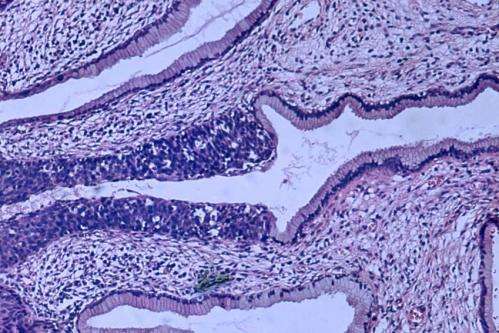Topical molecular imaging tracer enables real-time detection of cervical cancer

With the help of a topical fluorescent imaging agent, cervical cancer can be identified by physicians with a hand-held microscope, according to research published in the July issue of The Journal of Nuclear Medicine. Targeting the PARP1 enzyme that is overexpressed in cervical cancer, this optical imaging technique has the potential to revolutionize cervical cancer screenings and biopsies.
Most cases of cervical cancer are caused by the human papilloma virus (HPV), which can live in a woman's body for years before turning cervical cells cancerous. Despite the HPV vaccination and efforts in disease prevention with screening programs, cervical cancer still has a high incidence across the globe. It remains a significant problem in public health, especially in low-resource areas where HPV incidence is typically high.
"This clinical problem could be circumvented by a simple, in vivo, non-invasive, cost-effective, point-of-care method of diagnosis. We are attempting to address this unmet clinical need by using the topically applied targeted tracer, PARPi-FL." said Elizabeth Jewell, MD, MHSc, FACOG, FACS, attending physician on gynecologic oncology, vice chair of regional network and affiliates, director of MSK Monmouth operating rooms, and medical director of strategic partnerships at Memorial Sloan Kettering Cancer Center (MSK).
The study included cervical biopsies from animal models and human in which the expression of the PARP1 enzyme was assessed. Cervical cells from were stained with PARPi-FL and were imaged using a handheld confocal fiberoptic microscope. Researchers analyzed the expression of PARP1 in cervical cells, and histological exams were performed to verify the presence of the enzyme.
When imaging biopsies that contained tumors, PARPi-FL showed higher uptake in lesions compared to surrounding normal tissue, which corresponded to PARP1 expression in those areas. The tumors cells also showed a disorganized pattern and heterogeneously shaped nuclei, which was easily discernible using PARPi-FL.
"Assessing lesions using this molecular imaging-based approach is non-invasive, safe, painless, and can potentially be used to accurately diagnose and manage the treatment of several cancers, including cervical cancer. PARPi-FL can be used to specifically identify cancer cells in real-time during colposcopy procedures and could serve as a more precise guide for biopsies or even to replace the need to biopsy altogether," noted Paula Demetrio de Souza Franca, MD, visiting investigator at MSK.
More information: Paula Demétrio de Souza França et al, PARP1: A Potential Molecular Marker to Identify Cancer During Colposcopy Procedures, Journal of Nuclear Medicine (2020). DOI: 10.2967/jnumed.120.253575

















